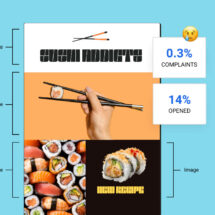11 Email Newsletter Best Practices
By Kelly Forst September 7, 2021
Launching an email newsletter can be a great marketing strategy for your growing business. Not only does an email newsletter give you a unique opportunity to connect with your customers, but a well-crafted newsletter can even drive sales and boost website traffic. Meanwhile, an email newsletter can also help to establish your company as an authority within your given industry.
Still, launching an email newsletter can be easier said than done—especially if you don’t have a lot of experience with this type of writing and ideation. Fortunately, with a few tips and best practices in mind, you can launch a successful email newsletter that will help your business reach new levels of success.
Decide on a newsletter type
Get started by determining what type of email marketing newsletter you want to launch. There are many different “styles” of newsletters to consider. One popular format is that of a news digest with articles that you and your marketing team craft yourself; this style is a great way to establish your business as a knowledgeable industry authority, though it can be time-consuming and labor-intensive to come up with article topics and carry them out.
Another option to consider is a curated newsletter that contains articles from other sources. This format is a lot easier and less time-consuming (since you’re not writing the articles yourself), but may not have as much of an impact on your brand reputation.
Set expectations up-front
The beauty of an email newsletter is that the people you’ll be sending it to are people who have exclusively signed up for it; this means that the people you’ll be reaching are already interested in what you have to say. Still, it’s important to establish and maintain trust between your brand and your audience by setting clear expectations for your newsletter upfront.
This means that on your newsletter sign-up page, you should explain in detail what type of content your readers should expect to see. If the newsletter is going to be partially promotional, be sure to let your audience know that they will occasionally see special deals or other promotional language.
Use a consistent, branded template
No matter how often you send out your company’s newsletter, it’s important that the template and design remain consistent. This means that you should spend some time creating a simple and branded template now that you’ll be able to easily use with each newsletter you send out.
When crafting a template, simplicity is key; for easy readability, for example, try to stick with a color scheme that does not include more than two or three colors.
Not sure where to begin when it comes to your email newsletter template? Tools like AWeber Smart Designer and Canova are great places to start; here, you can find all kinds of eye-catching templates that are easy to use.
Send at a consistent day/time
Timing is everything when it comes to your email newsletter. It will probably take a little trial and error to determine the best timing and frequency to send out your newsletter based on your audience’s habits. In general, however, you will receive the best click-through rates if you send out your newsletter first thing in the morning.
Once you determine the best day and time to send out your newsletter, stay consistent with it. You might even consider using scheduling software to automatically send out your newsletter at an exact day and time with each new publication.
Write punchy subject lines
While the content of your newsletter is undoubtedly important, you also don’t want to overlook the importance of a punchy email subject line. After all, your subject line is the first thing your audience will see—and it will play a major role in determining whether your reader will open the email or ignore it.
In general, you should try to keep your subject lines short (41 characters or fewer, according to a Fool.com article). Also, be careful not to overuse exclamation points or CAPSLOCK in your subject line, as this can come off as spammy.
Use a familiar and friendly “from” name
Believe it or not, the sender name you use for your email newsletter can make all the difference in its open rates, too. Rather than using a generic “from” name, consider addressing your newsletter directly from your company’s owner or another familiar name.
Encourage two-way dialogue
Your newsletter should always be a work in-progress, and one of the best ways to improve on your email newsletter is to encourage two-way dialogue. This means taking the time to ask for feedback on the content you’re sending out; you can do this by including an occasional survey or even using polls to track responses via click tracking.
Optimize with split tests
Another great way to optimize your newsletter is to use split tests, also commonly referred to as A/B tests. Specifically, a split test may involve sending out two different versions of your newsletter and tracking which one gets the highest open rate. You might even send out the same newsletter but with different subject lines to see which is most successful.
When A/B testing, can also try sending out your newsletter at different times of day or even on different days of the week. By tracking which version is most successful, you can get a better feel for what type of schedule to set for your email newsletter.
Offer easy unsubscribe options
At the end of the day, you only want people who are truly interested on your newsletter list. With this in mind, it’s important to offer easy unsubscribe options to your audience. Make sure you have a clear “unsubscribe” button or link included with each newsletter. This will improve your email deliverability, too, as many email platforms will automatically mark some newsletter content as spam if an unsubscribe link is not detected.
Segment your audience
Knowing your audience can also make all the difference when it comes to the success of your email newsletter. Furthermore, list segmentation can help you better target your audience with the content that is most relevant and useful to them.
There are many different ways to segment your audience. Consider, for example, segmenting by location. If you have customers in different states, sending out a unique newsletter to members in each state can help you better target each audience while sending them more relevant and useful content. You may also consider segmenting based on interests or even specific stages in the buying process.
Use a mobile-responsive design
These days, most emails are read on smartphones. With this in mind, it’s important to not only have a newsletter design that is readable on a computer/laptop, but on any mobile device as well. If your newsletter cannot be easily viewed on a mobile device, you run the risk of losing more than half of your readers. Take the time to test your email newsletter on a wide range of devices—and check out this useful guide on optimizing emails for mobile.
The bottom line on email newsletters
Crafting a successful email newsletter is something that takes a lot of time, research, and refining. By knowing your audience, choosing the right type of newsletter format, and making sure your publication is optimized across all devices—you’ll be off to a great start. With all these best practices in mind, you can begin reaping the benefits of a successful email newsletter, including a more engaged audience and increased website traffic.

